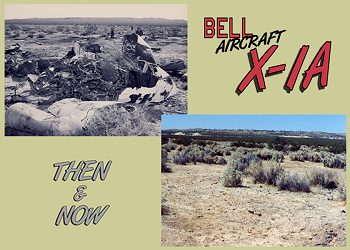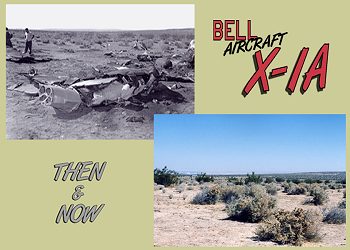Air & Space
In November 1992, Pete Merlin and Tony Moore decided to search for the X-1A crash site. They began their search in the Air Force Flight Test Center (AFFTC) History Office at Edwards Air Force Base.
Searching through old records and historical documents they collected every bit of information regarding the location of the impact. From the radio transcripts in the accident report, they determined that the X-1A was jettisoned from its B-29 mothership and crashed on the Edwards bombing range, near a target designated PB-3. Maps of the B-29s flight trajectory, however, indicate that it was nowhere near PB-3.
On another visit to the History Office, Pete and Tony discovered an old aerial photo of the range with target designations marked in faded grease pencil. Target PB-3 on the photo was in a different location from PB-3 on the current map. The target on the photo did, however, line up with the B-29's flight path. Apparently the targets were renumbered sometime after the X-1A accident.
This new information reduced the search area to a few square miles. Pete and Tony were excited, but deputy historian Cheryl Gumm was quick to throw a wet blanket on their enthusiasm. Cheryl explained that every five years range personnel clear all metal debris from the bombing range. During yet another visit, Cheryl told them that she flew over that part of the range in a helicopter and didn't see any sign of the crash site.
Undeterred, Pete and Tony began the process of obtaining permission to search the old PB-3 section of the bombing range. Representing themselves as The Aerospace Archeology Field Research Team, they submitted a detailed proposal to the AFFTC Museum and the base archeologist. Because the search area was on land under the jurisdiction of the Air Force's Phillips Laboratory, they also needed approval from that organization.
The approval process took an entire year. Eventually, the proposal was approved by AFFTC Museum curator Doug Nelson, AFFTC historian James O. Young, base archeologist Richard Norwood, and Phillips Lab operations and support director Col. Richard Poch.
While waiting for the paperwork to be approved, Pete and Tony continued their research. They called the NASA Dryden Flight Research Center Public Affairs office to inquire about historic photos of the accident site. They were told that such photos were not available. Soon after, they met Joy Nordberg from the NASA Dryden photo lab. Joy invited them to visit the lab and look through the negatives themselves. There they found exactly what they needed. There were several photos of the wreckage with distinctive landmarks in the background.
At long last, the expedition was approved. Phillips Lab public affairs director Ranney Adams told them they could schedule a four-hour visit in June, the hottest season at Edwards.
On the morning of 10 June 1994, Pete and Tony arrived at the Phillips Laboratory facility, known as "Rocket Ridge," with Tony's Father Len Moore, freelance writer Lance Thompson, and photographer Chad Slattery. Ranney Adams ushered them into a safety briefing in which they were warned of the natural and man-made hazards of the Edwards bombing range.
The six men piled into the Phillips Lab public affairs van and drove to the old PB-3 site, once used to test fire a tethered Minuteman missile for a silo launch experiment. The sun beat down relentlessly from the cloudless sky and there was no breeze to offer the least respite. The ground was littered with metal debris of all kinds including fragments of aluminum rocket casings and rusted steel bomb fragments, some dating back to World War II.
The team scoured the area as they moved southward. They crawled under an old barbed-wire fence with RESTRICTED AREA signs posted on both sides. After half an hour of searching they entered an area that resembled the photographs. Carefully matching the images to the terrain, they soon found themselves in a debris field that stood out from anything they had yet seen. The team quickly set to work, looking for significant artifacts and startling a Mojave Green rattlesnake from its rest beneath the sagebrush.
They found instrument faces (altimeter, airspeed indicator, propellant tank pressure indicator, etc.), an 8-day clock, pieces of external skin with white paint, and parts with Bell Aircraft inspection stamps. The ground was littered with battery casing fragments. Tony found a piece with hand-painted white letters "1-A." An hour later, he found a matching piece with "X-" and together they fit to spell "X-1-A." There was no question that they had found the X-1A crash site.
Lance Thompson successfully pitched his story idea to Perry Turner at AIR&SPACE/Smithsonian magazine. Perry though it was a great concept: two aviation buffs tracking down the forgotten history of America's most revolutionary aircraft. It smacked of Indiana Jones with a touch of X-Files thrown in. They are hunting for archeological treasures, he thought, like the fictional hero of Raiders of the Lost Ark, but they are hunting for technological remains as well. The idea of unearthing remnants of experimental vehicles on restricted government installations called to mind The X-Files television series that was popular at the time.
Perry decided to publish the article in the March 1995 issue of AIR&SPACE/Smithsonian, but he still needed a title. After much consideration it came to him and it was perfect: "The X-Hunters."

© Copyright 2004-, The X-Hunters. All rights reserved. Copyright Policy Privacy Policy Page last modified 05/01/2023



